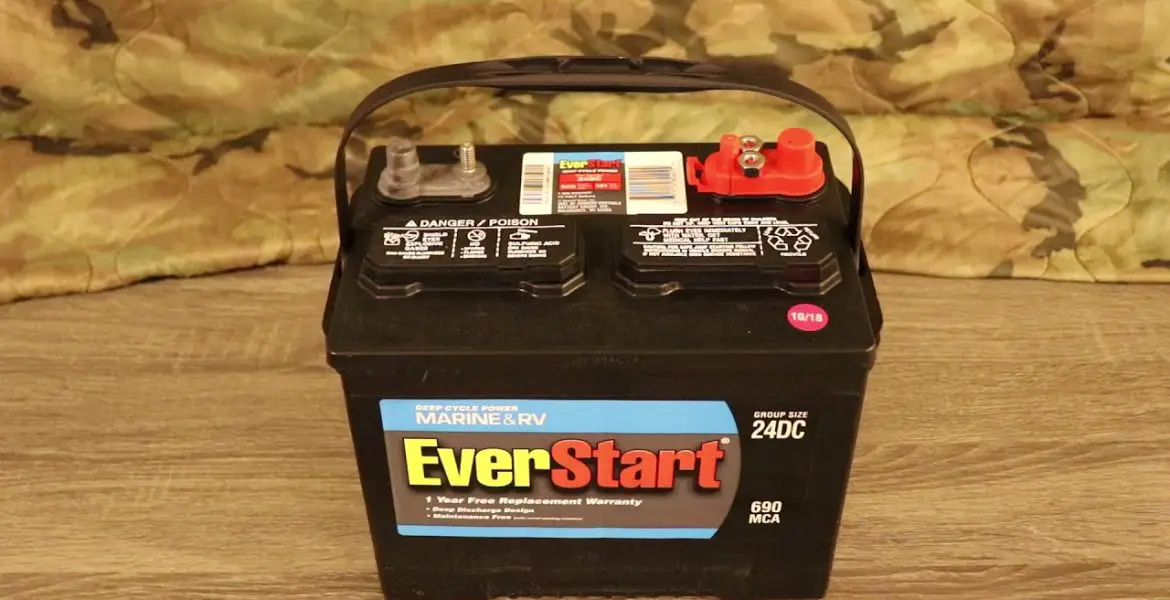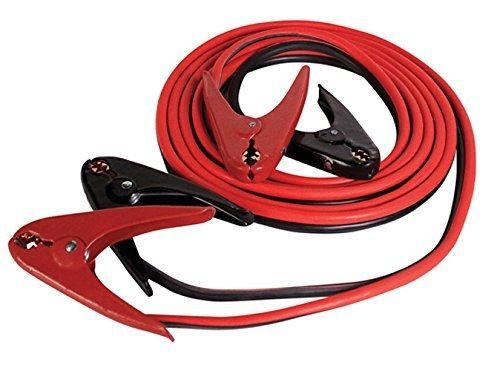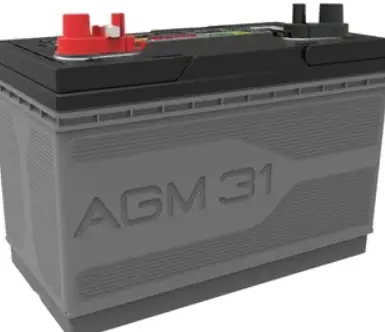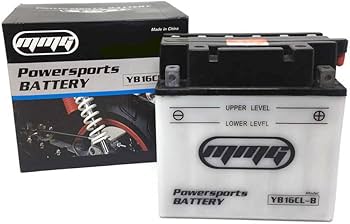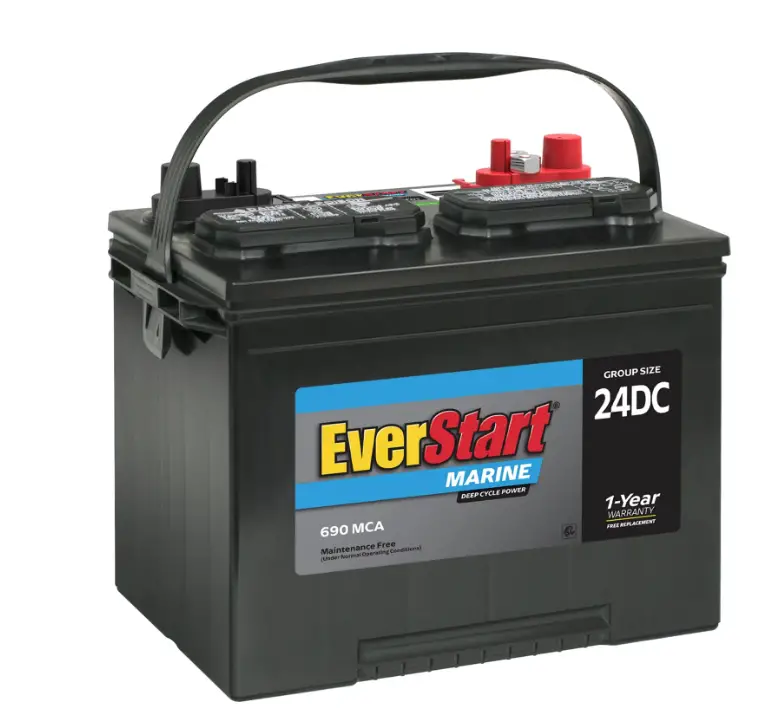
EverStart Lead Acid Marine & RV Deep Cycle Battery, Group Size 24DC 12 Volt, 690 MCA*
- CCA rating can vary by location. See store for details
- 1 Year free replacement
- Free battery testing and installation at your local Walmart Auto Care Center.
- Marine cranking amps (CCA): 690
- Reserve capacity: 140 minutes
- Lead acid design: Flooded
- Price shown does not include the Core Battery charge (varies by state). Core fees will be refunded to a gift card on all battery purchases placed on walmart.com
$89.74
As I sit here on my boat deck watching the sunset, I can’t help but appreciate the reliable power beneath my feet that makes this peaceful moment possible. If you’re diving into the world of marine, RV, or off-grid power solutions, you’ve likely encountered the Everstart 24DC battery. Today, I’m sharing my journey with this versatile power source and everything I’ve learned along the way.
When I first started exploring my options for reliable power, the sheer number of battery choices felt overwhelming. That’s why I’ve created this comprehensive guide—to help you understand if the Everstart 24DC is the right choice for your needs, how to get the most from it, and what to expect in terms of performance and longevity.
What Exactly Is the Everstart 24DC Battery?
The Everstart 24DC is a dual-purpose battery that sits in an interesting sweet spot in the battery world. When I first purchased mine, I was confused about its classification—is it a starting battery, a deep cycle battery, or something else entirely?
Here’s what I discovered: The Everstart 24DC is a dual-purpose battery designed to provide both starting power and moderate deep cycling capabilities, making it versatile for various applications. This hybrid nature is what makes it particularly interesting for those of us who need a battery that can handle multiple roles.
Manufactured by Johnson Controls for Walmart’s Everstart brand, this battery has become popular among boaters, RV enthusiasts, and those seeking reliable backup power solutions. The “24” in the name refers to its group size, while “DC” indicates its dual-purpose design.
Deep Cycle or Not? Understanding the Everstart 24DC’s True Nature
One of the most common questions I had (and I know many of you have too) is whether the Everstart 24DC is truly a deep cycle battery. The answer is a bit nuanced.
While it’s marketed as a marine/RV battery with deep cycle capabilities, it’s more accurate to call it a hybrid or dual-purpose battery. Pure deep cycle batteries are designed to provide steady power over long periods and can be discharged to 50-80% of their capacity regularly without damage.
The Everstart 24DC, however, strikes a balance. It can handle deeper discharges than a standard starting battery, but it’s not quite as robust as a true deep cycle battery. In my experience, it’s best to avoid regularly discharging it below 50% if you want to maximize its lifespan.
This makes it perfect for applications where you need both starting power (like cranking an engine) and some sustained power for accessories. For my weekend fishing trips, this dual functionality has been ideal—I can start the motor and run my fish finder and small appliances without needing two separate batteries.
The Nuts and Bolts: Everstart 24DC Specifications
Let’s get technical for a moment. After owning several of these batteries over the years, I’ve found that understanding the specifications helps set proper expectations for performance.
The Everstart 24DC typically offers:
- Cold Cranking Amps (CCA): Approximately 750-800 CCA, providing reliable starting power even in colder conditions
- Reserve Capacity: Around 140-160 minutes, giving you decent runtime for accessories
- Amp-Hour Rating: Approximately 75-85 Ah, though this isn’t always explicitly stated on the battery
- Group Size: 24, a common size that fits many applications
- Voltage: 12 volts, standard for most automotive and marine applications
- Weight: Approximately 45-50 pounds
- Dimensions: Roughly 10.25″ × 6.8″ × 8.9″ (L × W × H)
- Terminal Type: Top post
What impressed me most was the sturdy construction and vibration resistance. Marine environments can be rough, with constant motion and varying temperatures, but my Everstart 24DC has held up remarkably well to these challenges.
Longevity: How Long Can You Expect Your Everstart 24DC to Last?
Battery lifespan is always a critical consideration, especially when you’re relying on it for adventures far from home. Based on my experience and conversations with fellow boaters and RVers, the Everstart 24DC typically lasts between 3-5 years with proper maintenance and use.
Several factors affect this lifespan:
- Usage patterns: Frequent deep discharges will shorten the battery’s life
- Charging practices: Proper charging is crucial for longevity
- Temperature exposure: Extreme heat or cold can impact performance and lifespan
- Maintenance routine: Regular checks and maintenance extend battery life
- Storage conditions: How you store the battery during off-seasons matters
I’ve found that my batteries tend to last toward the upper end of this range because I’m diligent about maintenance and charging. The first Everstart 24DC I purchased lasted nearly 5 years before showing significant capacity reduction, which I consider excellent value for the price point.
Charging Your Everstart 24DC: Best Practices
Proper charging is perhaps the single most important factor in maximizing your battery’s lifespan. I learned this the hard way after prematurely killing my first marine battery years ago with improper charging habits.
For the Everstart 24DC, I recommend:
- Using a quality marine/RV battery charger with multiple charging stages
- Charging at a rate of about 10% of the amp-hour capacity (roughly 7-8 amps for this battery)
- Allowing the battery to complete a full charging cycle when possible
- Using a maintenance or float charger during periods of inactivity
I’ve had excellent results with chargers that offer conditioning modes, which can help prevent sulfation—a common killer of lead-acid batteries. When I’m not using my boat for extended periods, I keep the battery on a float charger, which maintains the optimal charge level without overcharging.
Remember that these batteries prefer to be kept at a high state of charge. Unlike pure deep cycle batteries, regularly discharging them deeply will significantly reduce their lifespan.
Marine Applications: Is the Everstart 24DC Suitable for Your Boat?
As someone who primarily uses the Everstart 24DC in a marine environment, I can confidently say it performs admirably for most recreational boating needs. However, whether it’s right for your specific situation depends on your boat and how you use it.
The Everstart 24DC works well for:
- Small to medium-sized boats with outboard motors
- Boats where the same battery handles both starting and accessories
- Weekend warriors who use their boats occasionally rather than daily
- Boats with moderate power demands from electronics and accessories
Where you might want to consider alternatives:
- Larger vessels with high-powered engines
- Boats with extensive electrical systems or many accessories
- Full-time liveaboards or those who spend extended time on the water
- Situations requiring very deep discharges regularly
For my 19-foot fishing boat with a 90HP outboard and basic electronics (fish finder, radio, navigation lights), the Everstart 24DC has been more than adequate. I can spend a full day on the water without worrying about power, even when frequently using the fish finder and occasionally running the radio.
The Amp-Hour Rating: Understanding Your Battery’s Capacity
The amp-hour (Ah) rating is a key specification that indicates how much energy a battery can store. While Everstart doesn’t always prominently display this figure on their packaging, the 24DC typically offers between 75-85 Ah.
What does this mean in practical terms? If you’re drawing 1 amp continuously, the battery would theoretically last 75-85 hours (in reality, it’s less because you shouldn’t discharge lead-acid batteries completely). At 10 amps, you’d get 7.5-8.5 hours theoretically.
This capacity has proven sufficient for my weekend boating needs. For example, my fish finder draws about 0.5 amps, so it could run for many hours on this battery. Even when I’m running multiple devices and occasionally using the trolling motor, I rarely deplete the battery significantly during a day on the water.
For RV users, this capacity can power interior lights, a water pump, and other small appliances for several days of moderate use when camping off-grid, which is why many RV enthusiasts also gravitate toward this battery.
Maintenance: Is the Everstart 24DC Truly Maintenance-Free?
The Everstart 24DC is marketed as a maintenance-free battery, which is mostly true—you don’t need to add water as with traditional flooded lead-acid batteries. However, “maintenance-free” doesn’t mean “ignore completely.”
Even with a maintenance-free design, I still perform these regular checks:
- Inspect terminals for corrosion (especially important in marine environments)
- Clean terminals as needed with a battery terminal cleaner
- Check that connections are tight and secure
- Verify proper charging system operation
- Test voltage periodically to monitor health
Marine environments are particularly harsh on batteries due to humidity, salt, and constant vibration. I’ve found that a quick monthly inspection prevents most problems before they start. A simple battery terminal protectant spray has proven invaluable in preventing the corrosion that’s so common around saltwater.
Value Proposition: Cost vs. Performance
When it comes to cost, the Everstart 24DC represents an excellent value in my experience. Typically priced between $90-130 (prices may vary), it offers a good balance between performance and affordability.
Compared to premium marine battery brands that can cost $200 or more, the Everstart provides comparable performance for many recreational users at a significantly lower price point. This value proposition is a major reason why I’ve stuck with this battery through multiple replacements.
The cost becomes even more reasonable when you consider the 3-5 year lifespan. Amortized over this period, you’re looking at roughly $25-40 per year for reliable power—a worthwhile investment for protecting your time on the water or road.
Where to Purchase Your Everstart 24DC Battery
As an Everstart product, the 24DC is primarily available at Walmart stores and through their online platform. This exclusivity can be both a benefit and limitation.
On the positive side, Walmart’s extensive network means these batteries are widely available across the country. When I needed an emergency replacement during a trip to Florida (far from my home in Michigan), I was able to quickly find a local Walmart and get back on the water the same day.
The downside is that you have fewer options for shopping around. However, Walmart typically offers competitive pricing, and their automotive centers can often help with installation if needed.
If you’re purchasing in-store, I recommend checking the manufacturing date stamped on the battery. Freshness matters with batteries, and I always try to select one manufactured within the last six months if possible.
Installation Guide: Setting Up Your Everstart 24DC
Installing the Everstart 24DC in your boat or RV is relatively straightforward, but proper installation ensures both safety and optimal performance.
Here’s the process I follow:
- Safety first: Disconnect the negative terminal first, then the positive when removing an old battery
- Clean the battery box/tray: Remove any corrosion or debris before installing the new battery
- Proper positioning: Secure the battery in its designated location to prevent movement
- Connection sequence: Connect the positive terminal first, then the negative when installing
- Terminal protection: Apply a battery terminal protectant to prevent future corrosion
- Secure attachments: Ensure all hold-downs and securing mechanisms are properly fastened
For RV installations, the process is similar, but you’ll want to ensure the battery is properly connected to your RV’s converter/charger system.
One tip I’ve found helpful: take a photo of your existing battery connections before removal. This simple step has saved me confusion more than once, especially with systems that have multiple wires connected to each terminal.
Warranty Protection: What’s Covered and for How Long
The Everstart 24DC typically comes with a warranty period ranging from 1-2 years, depending on the specific model and when you purchased it. This warranty generally covers manufacturing defects and premature failure but not issues resulting from improper use or maintenance.
In my experience, Walmart has been reasonable about honoring these warranties when legitimate issues arise. When one of my batteries showed signs of a cell failure just 14 months after purchase, they replaced it without much hassle—I simply needed to bring in the failed battery and my receipt.
I recommend keeping your receipt in a safe place or taking a photo of it and storing it digitally. The warranty period typically starts from the date of purchase, so this documentation is essential for any future claims.
Solar Applications: Can the Everstart 24DC Work with Solar Systems?
With the growing popularity of solar power for RVs, boats, and off-grid cabins, many people wonder if the Everstart 24DC is suitable for solar applications. The answer is yes, with some caveats.
The dual-purpose nature of the Everstart 24DC makes it acceptable for light to moderate solar applications. I’ve successfully used mine with a 100-watt solar panel to maintain charge while at anchor or when camping in my RV.
However, for dedicated solar energy storage, a true deep cycle battery or lithium battery would be more appropriate. The Everstart 24DC isn’t designed for the frequent deep discharge cycles that often occur in solar-only power systems.
If you’re using solar primarily as a maintenance charging system rather than your sole power source, the Everstart 24DC can perform quite well. Just be mindful of its discharge limitations and try to keep it above 50% charge whenever possible.
Maintaining Your Battery for Maximum Lifespan
Beyond the basic maintenance mentioned earlier, several practices can help extend your Everstart 24DC’s useful life:
- Regular use: Batteries prefer to be used rather than sitting idle
- Proper storage: If storing long-term, disconnect the battery and keep it in a cool, dry place
- Periodic charging: Even when stored, charge the battery every 1-2 months
- Avoid deep discharges: Try not to drop below 50% charge when possible
- Temperature management: Protect from extreme temperatures, especially heat
- Secure mounting: Prevent excessive vibration which can damage internal components
I’ve made it a habit to check my battery’s voltage before each boating trip. A healthy, fully-charged Everstart 24DC should read around 12.6-12.8 volts at rest. If I see readings consistently below 12.4 volts, I know it’s time for a thorough charging session.
Comparing the Everstart 24DC to Other Everstart Models
Everstart offers several battery models, and understanding the differences can help you choose the right one for your needs.
The main Everstart battery types include:
- Everstart Maxx: Premium automotive starting batteries
- Everstart Plus: Mid-range automotive starting batteries
- Everstart Marine: Various marine batteries, including the 24DC
- Everstart Lawn & Garden: Smaller batteries for outdoor equipment
Compared to pure starting batteries in the Everstart lineup, the 24DC offers better deep cycling capability but somewhat less instantaneous starting power. Compared to true deep cycle batteries, it provides better starting performance but less cycle life.
I chose the 24DC specifically because I needed both starting power for my outboard and sustained power for accessories. If your application only requires one of these functions, a more specialized battery might serve you better.
Testing Your Battery’s Health
Monitoring your battery’s health can prevent unexpected failures and help you determine when replacement is necessary. I check my battery’s condition a few times per year using these methods:
- Voltage testing: A fully charged battery should read 12.6-12.8V at rest
- Load testing: Apply a load and monitor voltage drop (many auto parts stores offer this service free)
- Specific gravity testing: For batteries with accessible cells, a hydrometer can measure electrolyte condition
- Performance monitoring: Track how long the battery lasts under typical usage conditions
One simple test I perform regularly is the “voltage recovery test.” I check the voltage after the battery has been at rest (unused for at least a few hours), then turn on a significant load for a minute, turn it off, and check how quickly the voltage recovers. A healthy battery should recover fairly quickly, while a failing battery will take longer to return to its resting voltage.
Understanding Reserve Capacity: The Runtime Metric
Reserve capacity (RC) is an important specification that tells you how long your battery can sustain a 25-amp draw until the voltage drops to 10.5 volts. For the Everstart 24DC, this is typically around 140-160 minutes.
This figure is particularly relevant for marine and RV users who need to know how long their essential systems can run if the charging system fails. For example, if your engine dies and you need to rely on your battery for navigation equipment and communication, the reserve capacity gives you an estimate of your available time.
I’ve found this specification more useful than amp-hours when planning how I’ll use my battery throughout the day. Knowing I have roughly 140 minutes of reserve capacity helps me budget my power use during a day on the water.
Powering a Trolling Motor: Can the Everstart 24DC Handle It?
Many anglers wonder if the Everstart 24DC can power a trolling motor effectively. Based on my experience, the answer is yes for light to moderate use, but with some limitations.
For smaller trolling motors (30-40 lbs thrust) used intermittently, the Everstart 24DC performs adequately. I’ve used mine with a 30 lb thrust motor for several hours of non-continuous use during fishing trips.
However, for larger trolling motors (45+ lbs thrust) or for extended continuous use, a dedicated deep cycle marine battery would be a better choice. The dual-purpose nature of the 24DC means it’s not optimized for the deep discharges that high-powered trolling motors can demand.
If trolling is your primary activity, consider either using a dedicated deep cycle battery or carrying a second battery specifically for your trolling motor.
Responsible Disposal: What to Do with Your Old Battery
When your Everstart 24DC reaches the end of its useful life, proper disposal is essential. These batteries contain lead and acid, which can be harmful to the environment if not handled correctly.
Fortunately, lead-acid batteries are one of the most recycled products in America, with recycling rates over 99%. Here’s how I handle disposal:
- Return to retailer: Most places that sell batteries, including Walmart, accept old batteries for recycling
- Exchange programs: Many retailers offer a core credit when you return your old battery while purchasing a new one
- Recycling centers: Local hazardous waste facilities or recycling centers accept automotive batteries
- Auto parts stores: Chains like AutoZone, Advance Auto Parts, and O’Reilly typically accept old batteries
I’ve always opted to return my old batteries to Walmart when purchasing a replacement. Not only is this convenient, but they typically offer a core charge credit (usually $5-15) on your new battery purchase when you return the old one.
Weather Considerations: Performance in Extreme Conditions
Battery performance is significantly affected by temperature, and the Everstart 24DC is no exception. Understanding these effects can help you manage expectations and take appropriate precautions.
In cold weather:
- Starting capacity decreases (batteries can lose 30-50% of their starting power in very cold conditions)
- Charging efficiency is reduced
- The battery may appear “dead” when it’s actually just cold
In hot weather:
- Battery life is shortened (heat accelerates internal corrosion and water loss)
- Self-discharge rates increase
- The battery may require more frequent maintenance and charging
I’ve used my Everstart 24DC in both Michigan winters and Florida summers, and it’s generally performed well across these conditions with proper care. In winter, I remove the battery from my boat and store it in my garage, which stays above freezing. In summer, I ensure the battery compartment has adequate ventilation to prevent heat buildup.
My Personal Experience: Three Years with the Everstart 24DC
After three years of using the Everstart 24DC as my primary battery, I can share some real-world observations that might help you decide if it’s right for your needs.
Reliability has been excellent for my use case. I typically use my boat 2-3 times per month during the season, with occasional longer trips. The battery consistently starts my outboard without hesitation and powers my electronics throughout the day.
The value proposition has been perhaps the most impressive aspect. While I could have spent twice as much on a premium marine battery, the Everstart has provided all the performance I need at a much more reasonable price point.
Maintenance has been minimal—just occasional terminal cleaning and keeping it on a maintainer during the off-season. For a lead-acid battery, it’s about as hands-off as you can get.
The dual-purpose design has proven perfect for my needs. I don’t have space for multiple batteries in my smaller boat, so having one battery that handles both starting and accessory duties has been ideal.
Final Thoughts: Is the Everstart 24DC Right for You?
After thousands of words exploring the Everstart 24DC battery, the ultimate question remains: is it the right choice for your needs?
Based on my experience, I’d recommend the Everstart 24DC if:
- You need a dual-purpose battery that can both start engines and power accessories
- Your deep cycling needs are moderate rather than heavy
- You’re looking for good value at a reasonable price point
- You have a smaller boat, RV, or similar application
- You perform regular maintenance and proper charging
You might want to consider alternatives if:
- You need extreme starting power for very large engines
- Your application requires frequent deep discharges
- You’re looking for the absolute longest lifespan regardless of cost
- You need specialized features like extreme vibration resistance
For most recreational boaters, RVers, and outdoor enthusiasts, the Everstart 24DC hits a sweet spot of performance, versatility, and value that’s hard to beat. It’s not the most specialized battery on the market, but its jack-of-all-trades nature makes it perfect for those who need a reliable power source without breaking the bank.
Whatever you decide, I hope this guide has helped illuminate the sometimes confusing world of batteries and given you the information you need to make the right choice for your adventures. Here’s to many more sunsets on the water, nights under the stars in your RV, or whatever activities your battery will be powering!

